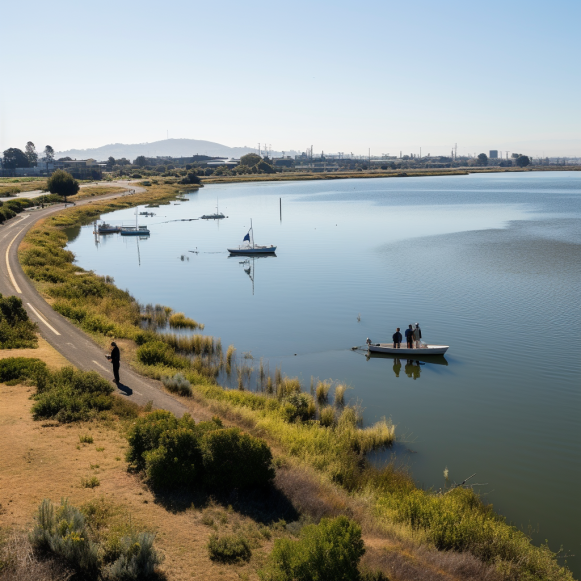Officials: Oakland can’t solve its “pirate” problem unless it fixes its homeless crisis first

Enforcement agencies say there’s little they can do about crime in the estuary
The state agency in charge of ensuring the wellbeing of bay waterways agreed the situation was unacceptable in one of the first public meetings since the Alameda boating community raised the alarm about a “pirate” crime wave in the Oakland Estuary.
However, it provided no immediate solution to a crime spree that peaked a month ago when dozens of small boats and dinghies were stolen, stripped for parts, and frequently sunk, and 70-year-old and 80-year-old boaters embarked on vigilante-style missions to recover them. Boaters discussed “hand-to-hand combat,” and it seemed like it was only a matter of time before someone was hurt.
RELATED: A pirate crime spree and vigilantes turn the Oakland estuary into a lawless zone
“I understand the people who live on the water’s frustration because it affects them and their daily lives,” said Marie Gilmore, chair of the San Francisco Bay Conservation and Development Commission.
Members of the boating community expressed their concerns about crime and “anchor-outs”–a catch-all term for boaters living rent-free in public waterways throughout the Bay Area in the Oakland estuary–again at the meeting this week.
However, as presentations by the Oakland Police Department, the City of Oakland, and the Alameda Police Department demonstrated, Oakland cannot solve its “pirate” problem without first addressing its homeless crisis. The Bay’s enforcement challenges are complex, and the estuary, in particular, appears to be falling through the cracks.
The city of Oakland still has only one full-time marine patrol officer, though he is training others. According to an officer with the Alameda Police Department, they only have enough staff to put a patrol boat out on the water three times per month. The Coast Guard, which has a base in the estuary, a narrow channel of water that separates the cities of Oakland and Alameda, has promised greater collaboration with both departments, but it’s unclear how that assistance will be delivered.
Meanwhile, Oakland is experiencing an unprecedented level of homelessness. City staff argued in a report that action on the estuary is hampered by laws governing how they clear encampments and the sheer number of people who remain homeless.
Although the city’s report highlighted the long-term efforts they’re taking to address homelessness, a plain-language summary of their stance could be boiled down to one simple idea: ‘We get that you’re worried about the estuary, but we’re underwater right now’.
“We want to make sure the commission understands the magnitude of homelessness in Oakland,” said LaTonda Simmons, an assistant city administrator. “The city is struggling to keep up with the growth of encampments.”
According to Simmons, the number of homeless encampments in Oakland in 2020 is expected to be around 150. By 2023, the number had nearly tenfolded to 1,300, which Simmons claimed was an undercount. Today, the number of unhoused people in the city vastly outnumbers the number of available shelter beds, and Oakland is home to nearly half of all unhoused people in Alameda County.
Meanwhile, Simmons claims that crime has increased in homeless encampments, citing drug dealing, violence, and shootings as obstacles to cleanup efforts.
Given the context of Simmons’ presentation, the real surprise may not be that concerns about homelessness and crime have spread to the estuary, but rather that it has remained relatively unaffected for so long.
“Clearly the problem has vastly outstripped your current resources to deal with it,” said Gilmore.
Nonetheless, at least for estuary advocates, the meeting demonstrated some signs of progress. Both Oakland and Alameda have received over $100,000 in funding from the Surrendered and Abandoned Vessel Exchange, a state grant program, in the last month. City of Oakland staff stated that the money, which can be used to remove abandoned and sunken boats from the estuary, would be expedited through the City Council.
Oakland’s deputy city administrator, Joe DeVries, stated that the city will begin removing illegal live-aboard vessels from the estuary in December.
However, as Simmons noted in her report, Oakland has struggled greatly with the cost and effort of clearing encampments on land, only to have people quickly return. Even if all of the illegal anchor-out boats are removed from the estuary in December, there is no guarantee they will not return.
Amanda Veta-Nguyen, a member of the anchor-out community who is currently living in a boat near the Jack London Aquatic Center in Oakland, believes the city should consider providing the same type of “safe parking” for people living in boats in the estuary that they do for RVs.
“Why can’t they do that for the waterway?” Veta-Nguyen explained. “I’m only out here because if I leave my boat out here unattended, people are going to steal it.”
Other members of the anchor-out community may find themselves in one of the thousands of encampments strewn across Oakland or elsewhere in the Bay if they are removed from the water.
“We don’t want to be in a situation where we just move this problem from one part of the bay to another,” said Steve Orosz, the harbor master of Richmond’s Marina Bay Yacht Harbor, during public comment. “We’re just one economic downturn away from having a flood of derelict boats.”




